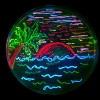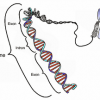DNA Interactive

Fluorescent Controversy
Aug 13th
After conducting a bacterial transformation lab with my students, where we genetically engineer the bacteria to make a jellyfish protein that fluoresces, we always jump into the discussion of why this technique is important. I always try to get the students to think of ways that this could benefit them.
Among other uses, we finally get to the idea that these bacterial cells can be used as factories to make any protein you want, even human proteins. It all depends on what recipe, or gene, you give them. If you give them the recipe to make human insulin, they will. And then More >

Human Genome Project
May 25th
The initial goal of the Human Genome Project was to find, map and sequence all of the genes within the human genome. Since the completion of the initial draft back in 2000, the White House predicted that this would lead to a new era of molecular medicine, bringing new ways to prevent, diagnose, treat and cure disease.
It has been amazing to see what we have learned since then, but even more interesting to think of where this could go in the future. Hopefully soon we will be able to apply this on a more individual basis, with people being able to More >

Pharm Crops
Apr 19th
What if vaccines could be eaten instead of injected? Scientists began developing subunit vaccines in the late 1980s; these are vaccines which contain isolated pathogen proteins. It seems that proteins from viruses, bacteria, and parasites can trigger an immune response (are antigenic) even when the pathogens are not present. Furthermore, these proteins can be antigenic when eaten, which has led scientists to explore whether we can genetically modify food sources to create edible vaccines.
Dr. Charles Arntzen (Co-Director of the Center for Infectious Diseases and Vaccinology, The Biodesign Institute and Florence Ely Nelson Presidential Chair, Arizona State University) has spearheaded the More >

Sexual Selection
Apr 1st
When we think about all of the living things on Earth, we immediately see how different we all are from each other. Many of these traits that might seem bizarre to us, evolutionarily speaking, have a tremendous amount to do with the survival. Many traits have been selected for by the opposite sex, because it will help the passing on of their design information.
One very amazing example of this is the Widowbirds that live in the grasslands of southern and eastern Africa. During the non-mating season, the males and females look very similar to one another. Once breeding season begins, More >

Whole Genome Sequencing: Mutation Diagnosis of the Future!?
Mar 19th
Two Scientific teams independently attempted a new approach to discovering the cause for certain diseases by sequencing the whole genome of their patients. This technique was done not only to help their current patients but hopefully to shed light on other common killers such as heart disease, diabetes and Alzheimer’s.
One Scientist from Baylor College of Medicine in Houston Texas, Richard A. Gibbs, decided to test whole genome sequencing on his colleague, a medical geneticist, Dr. James R. Lupski, who suffers from a rare genetic disorder known as Charcot-Marie-Tooth Neuropathy (this disease damages nerves to the hands and feet and causes More >

Synthetic Biology
Feb 16th
Genetic engineering is a common tool used by molecular biologists to manipulate the genes of an organism. One of the common forms of this technology is to transform bacteria with a gene from another organism, for example, the green fluorescent protein gene from the Pacific Jellyfish. Giving this gene to bacteria will allow them to produce this protein and literally glow green. This technique has been widely used by pharmaceutical companies to produce human proteins as well to treat some common genetic disorders, such as diabetes. To see more on insulin production inside bacteria see, visit our DNAi.org section on manipulation.
Undergraduate students are now More >
AIDS Cure?
Feb 5th
How do you cure a man of both leukemia and AIDS with just one procedure? No, it’s not a trick question: an American leukemia patient living in Berlin received a bone marrow transplant that also resolved his AIDS.
In a bone marrow transplant, a patient’s own marrow is destroyed and replaced with tissue from a donor. The donor marrow contains healthy hematopoietic stem cells (HSCs, adult stem cells in the blood) which repopulate the patient’s body with healthy red and white blood cells for oxygen transport and immune defense. Just as with other varieties of organ donation, tissue-type matches are critical. In the case of More >

Could Jurassic Park have been right?: Venomous Dinos
Jan 28th
65 million years ago one of the most amazing and dynamic groups of organisms vanished from our planet, the Dinosaurs. All that remains are fossil records with gaping holes and missing data.
Only recently has science began to unveil some of the mysteries of these behemoths. For decades it was believed that ancient DNA, proteins, and soft tissue could not be preserved over millions of years. Now, during the last 2 years, soft tissue was discovered deep inside the thigh bones of T-Rex.
There are times that inspiration for truth comes from science fiction, such as the best selling novel and blockbuster More >

Antibody Diversity
Jan 4th
There are many different types of proteins that get made inside of human cells, including structure proteins, such as keratin and collagen, enzymes, and messenger proteins such as hormones. One large group that I forgot to mention, and that intrigues me the most, is the wide variety of different antibodies that get made in our blood cells. There are over a billion different types of antibodies that get made over the course of a lifetime, and each is able to identify antigens from foreign objects, such as viruses or bacteria, and elicits an immune response.
The amazing part of antibody production is the More >

Genetic Codes for Skin and Lung Cancer have been Busted!
Dec 22nd
“Cancer is a leading cause of death worldwide and claims more than 7 million lives each year according to the World Health Organization.”
Cancer cells have mutations in their genes that render them unable to respond to signals that regulate cell division. These cells grow uncontrollably and can invade normal tissue in other locations of the body and cause disrupted functions of major organs. This is why cancer is so deadly.
A mutagen is a physical or chemical substance that can alter genetic material in cells. DNA can be damaged or changed (mutated). Cancer cells have changes in the genes themselves. These changes More >
